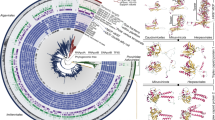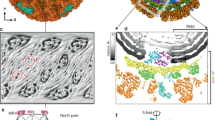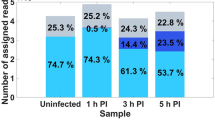Abstract
MutS proteins are ubiquitous in cellular organisms and have important roles in DNA mismatch repair or recombination. In the virus world, the amoeba-infecting Mimivirus, as well as the recently sequenced Cafeteria roenbergensis virus are known to encode a MutS related to the homologs found in octocorals and ɛ-proteobacteria. To explore the presence of MutS proteins in other viral genomes, we performed a genomic survey of four giant viruses (‘giruses’) (Pyramimonas orientalis virus (PoV), Phaeocystis pouchetii virus (PpV), Chrysochromulina ericina virus (CeV) and Heterocapsa circularisquama DNA virus (HcDNAV)) that infect unicellular marine algae. Our analysis revealed the presence of a close homolog of Mimivirus MutS in all the analyzed giruses. These viral homologs possess a specific domain structure, including a C-terminal HNH-endonuclease domain, defining the new MutS7 subfamily. We confirmed the presence of conserved mismatch recognition residues in all members of the MutS7 subfamily, suggesting their role in DNA mismatch repair rather than DNA recombination. PoV and PpV were found to contain an additional type of MutS, which we propose to call MutS8. The MutS8 proteins in PoV and PpV were found to be closely related to homologs from ‘Candidatus Amoebophilus asiaticus’, an obligate intracellular amoeba-symbiont belonging to the Bacteroidetes. Furthermore, our analysis revealed that MutS7 and MutS8 are abundant in marine microbial metagenomes and that a vast majority of these environmental sequences are likely of girus origin. Giruses thus seem to represent a major source of the underexplored diversity of the MutS family in the microbial world.
Similar content being viewed by others
Log in or create a free account to read this content
Gain free access to this article, as well as selected content from this journal and more on nature.com
or
References
Abascal F, Zardoya R, Posada D . (2005). ProtTest: selection of best-fit models of protein evolution. Bioinformatics 21: 2104–2105.
Abdelnoor RV, Christensen AC, Mohammed S, Munoz-Castillo B, Moriyama H, Mackenzie SA . (2006). Mitochondrial genome dynamics in plants and animals: convergent gene fusions of a MutS homologue. J Mol Evol 63: 165–173.
Altschul SF, Madden TL, Schaffer AA, Zhang J, Zhang Z, Miller W et al. (1997). Gapped BLAST and PSI-BLAST: a new generation of protein database search programs. Nucleic Acids Res 25: 3389–3402.
Bogani F, Corredeira I, Fernandez V, Sattler U, Rutvisuttinunt W, Defais M et al. (2010). Association between the Herpes Simplex Virus-1 DNA Polymerase and Uracil DNA Glycosylase. J Biol Chem 285: 27664–27672.
Brugler MR, France SC . (2008). The mitochondrial genome of a deep-sea bamboo coral (Cnidaria, Anthozoa, Octocorallia, Isididae): genome structure and putative origins of replication are not conserved among octocorals. J Mol Evol 67: 125–136.
Claverie JM, Abergel C . (2010). Mimivirus: the emerging paradox of quasi-autonomous viruses. Trends Genet 26: 431–437.
Claverie JM, Grzela R, Lartigue A, Bernadac A, Nitsche S, Vacelet J et al. (2009). Mimivirus and Mimiviridae: giant viruses with an increasing number of potential hosts, including corals and sponges. J Invertebr Pathol 101: 172–180.
Claverie JM, Ogata H . (2009). Ten good reasons not to exclude giruses from the evolutionary picture. Nat Rev Microbiol 7: 615; author reply 615.
Claverie JM, Ogata H, Audic S, Abergel C, Suhre K, Fournier PE . (2006). Mimivirus and the emerging concept of ‘giant’ virus. Virus Res 117: 133–144.
Culligan KM, Meyer-Gauen G, Lyons-Weiler J, Hays JB . (2000). Evolutionary origin, diversification and specialization of eukaryotic MutS homolog mismatch repair proteins. Nucleic Acids Res 28: 463–471.
Drake JW . (1991). A constant rate of spontaneous mutation in DNA-based microbes. Proc Natl Acad Sci USA 88: 7160–7164.
Eddy SR . (1996). Hidden Markov models. Curr Opin Struct Biol 6: 361–365.
Eisen JA . (1998). A phylogenomic study of the MutS family of proteins. Nucleic Acids Res 26: 4291–4300.
Filee J, Forterre P . (2005). Viral proteins functioning in organelles: a cryptic origin? Trends Microbiol 13: 510–513.
Fischer MG, Allen MJ, Wilson WH, Suttle CA . (2010). Giant virus with a remarkable complement of genes infects marine zooplankton. Proc Natl Acad Sci USA 107: 19508–19513.
Fukui K, Nakagawa N, Kitamura Y, Nishida Y, Masui R, Kuramitsu S . (2008). Crystal structure of MutS2 endonuclease domain and the mechanism of homologous recombination suppression. J Biol Chem 283: 33417–33427.
Furuta M, Schrader JO, Schrader HS, Kokjohn TA, Nyaga S, McCullough AK et al. (1997). Chlorella virus PBCV-1 encodes a homolog of the bacteriophage T4 UV damage repair gene denV. Appl Environ Microbiol 63: 1551–1556.
Guindon S, Gascuel O . (2003). A simple, fast, and accurate algorithm to estimate large phylogenies by maximum likelihood. Syst Biol 52: 696–704.
Han MV, Zmasek CM . (2009). phyloXML: XML for evolutionary biology and comparative genomics. BMC Bioinformatics 10: 356.
Iyer RR, Pluciennik A, Burdett V, Modrich PL . (2006). DNA mismatch repair: functions and mechanisms. Chem Rev 106: 302–323.
Jacobsen A, Bratbak G, Heldal M . (1996). Isolation and characterization of a virus infecting Phaeocystis pouchetii (Prymnesiophyceae). J Phycol 32: 923–927.
Kumar S, Nei M, Dudley J, Tamura K . (2008). MEGA: a biologist-centric software for evolutionary analysis of DNA and protein sequences. Brief Bioinform 9: 299–306.
La Scola B, Campocasso A, N’Dong R, Fournous G, Barrassi L, Flaudrops C et al. (2010). Tentative characterization of new environmental giant viruses by MALDI-TOF mass spectrometry. Intervirology 53: 344–353.
La Scola B, Desnues C, Pagnier I, Robert C, Barrassi L, Fournous G et al. (2008). The virophage as a unique parasite of the giant mimivirus. Nature 455: 100–104.
Larkin MA, Blackshields G, Brown NP, Chenna R, McGettigan PA, McWilliam H et al. (2007). Clustal W and Clustal X version 2.0. Bioinformatics 23: 2947–2948.
Larsen JB, Larsen A, Bratbak G, Sandaa RA . (2008). Phylogenetic analysis of members of the Phycodnaviridae virus family, using amplified fragments of the major capsid protein gene. Appl Environ Microbiol 74: 3048–3057.
Le SQ, Gascuel O . (2008). An improved general amino acid replacement matrix. Mol Biol Evol 25: 1307–1320.
Legendre M, Audic S, Poirot O, Hingamp P, Seltzer V, Byrne D et al. (2010). mRNA deep sequencing reveals 75 new genes and a complex transcriptional landscape in Mimivirus. Genome Res 20: 664–674.
Lin Z, Nei M, Ma H . (2007). The origins and early evolution of DNA mismatch repair genes--multiple horizontal gene transfers and co-evolution. Nucleic Acids Res 35: 7591–7603.
Malik HS, Henikoff S . (2000). Dual recognition-incision enzymes might be involved in mismatch repair and meiosis. Trends Biochem Sci 25: 414–418.
McFadden CS, France SC, Sanchez JA, Alderslade P . (2006). A molecular phylogenetic analysis of the Octocorallia (Cnidaria: Anthozoa) based on mitochondrial protein-coding sequences. Mol Phylogenet Evol 41: 513–527.
Miller WG, Parker CT, Rubenfield M, Mendz GL, Wosten MM, Ussery DW et al. (2007). The complete genome sequence and analysis of the epsilonproteobacterium Arcobacter butzleri. PLoS ONE 2: e1358.
Monier A, Claverie JM, Ogata H . (2007). Horizontal gene transfer and nucleotide compositional anomaly in large DNA viruses. BMC Genomics 8: 456.
Monier A, Larsen JB, Sandaa RA, Bratbak G, Claverie JM, Ogata H . (2008). Marine mimivirus relatives are probably large algal viruses. Virol J 5: 12.
Moran NA, McLaughlin HJ, Sorek R . (2009). The dynamics and time scale of ongoing genomic erosion in symbiotic bacteria. Science 323: 379–382.
Moran NA, Wernegreen JJ . (2000). Lifestyle evolution in symbiotic bacteria: insights from genomics. Trends Ecol Evol 15: 321–326.
Moreira D, Philippe H . (1999). Smr: a bacterial and eukaryotic homologue of the C-terminal region of the MutS2 family. Trends Biochem Sci 24: 298–300.
Nakagawa S, Takaki Y, Shimamura S, Reysenbach AL, Takai K, Horikoshi K . (2007). Deep-sea vent epsilon-proteobacterial genomes provide insights into emergence of pathogens. Proc Natl Acad Sci USA 104: 12146–12150.
Natrajan G, Lamers MH, Enzlin JH, Winterwerp HH, Perrakis A, Sixma TK . (2003). Structures of Escherichia coli DNA mismatch repair enzyme MutS in complex with different mismatches: a common recognition mode for diverse substrates. Nucleic Acids Res 31: 4814–4821.
Notredame C, Higgins DG, Heringa J . (2000). T-Coffee: A novel method for fast and accurate multiple sequence alignment. J Mol Biol 302: 205–217.
Ogata H, Claverie JM . (2007). Unique genes in giant viruses: regular substitution pattern and anomalously short size. Genome Res 17: 1353–1361.
Ogata H, La Scola B, Audic S, Renesto P, Blanc G, Robert C et al. (2006). Genome sequence of Rickettsia bellii illuminates the role of amoebae in gene exchanges between intracellular pathogens. PLoS Genet 2: e76.
Ogata H, Toyoda K, Tomaru Y, Nakayama N, Shirai Y, Claverie JM et al. (2009). Remarkable sequence similarity between the dinoflagellate-infecting marine girus and the terrestrial pathogen African swine fever virus. Virol J 6: 178.
Pinto AV, Mathieu A, Marsin S, Veaute X, Ielpi L, Labigne A et al. (2005). Suppression of homologous and homeologous recombination by the bacterial MutS2 protein. Mol Cell 17: 113–120.
Pont-Kingdon GA, Okada NA, Macfarlane JL, Beagley CT, Wolstenholme DR, Cavalier-Smith T et al. (1995). A coral mitochondrial mutS gene. Nature 375: 109–111.
Raoult D, Audic S, Robert C, Abergel C, Renesto P, Ogata H et al. (2004). The 1.2-megabase genome sequence of Mimivirus. Science 306: 1344–1350.
Redrejo-Rodriguez M, Ishchenko AA, Saparbaev MK, Salas ML, Salas J . (2009). African swine fever virus AP endonuclease is a redox-sensitive enzyme that repairs alkylating and oxidative damage to DNA. Virology 390: 102–109.
Rusch DB, Halpern AL, Sutton G, Heidelberg KB, Williamson S, Yooseph S et al. (2007). The Sorcerer II Global Ocean Sampling expedition: northwest Atlantic through eastern tropical Pacific. PLoS Biol 5: e77.
Sandaa RA, Heldal M, Castberg T, Thyrhaug R, Bratbak G . (2001). Isolation and characterization of two viruses with large genome size infecting Chrysochromulina ericina (Prymnesiophyceae) and Pyramimonas orientalis (Prasinophyceae). Virology 290: 272–280.
Sanjuan R, Nebot MR, Chirico N, Mansky LM, Belshaw R . (2010). Viral mutation rates. J Virol 84: 9733–9748.
Schofield MJ, Hsieh P . (2003). DNA mismatch repair: molecular mechanisms and biological function. Annu Rev Microbiol 57: 579–608.
Sievert SM, Scott KM, Klotz MG, Chain PS, Hauser LJ, Hemp J et al. (2008). Genome of the epsilonproteobacterial chemolithoautotroph Sulfurimonas denitrificans. Appl Environ Microbiol 74: 1145–1156.
Simonsen S, Moestrup O . (1997). Toxicity tests in eight species of Chrysochromulina (Haptophyta). Can J Bot 75: 129–136.
Srinivasan V, Tripathy DN . (2005). The DNA repair enzyme, CPD-photolyase restores the infectivity of UV-damaged fowlpox virus isolated from infected scabs of chickens. Vet Microbiol 108: 215–223.
Tarutani K, Nagasaki K, Itakura S, Yamaguchi M . (2001). Isolation of a virus infecting the novel shellfish-killing dinoflagellate Heterocapsa circularisquama. Aquat Microb Ecol 23: 103–111.
UniProtConsortium (2010). The Universal Protein Resource (UniProt) in 2010. Nucleic Acids Res 38: D142–D148.
Van Etten JL, Lane LC, Dunigan DD . (2010). DNA Viruses: The Really Big Ones (Giruses). Annu Rev Microbiol 64: 83–99.
Wu SY, Culligan K, Lamers M, Hays J . (2003). Dissimilar mispair-recognition spectra of Arabidopsis DNA-mismatch-repair proteins MSH2*MSH6 (MutSalpha) and MSH2*MSH7 (MutSgamma). Nucleic Acids Res 31: 6027–6034.
Yutin N, Wolf YI, Raoult D, Koonin EV . (2009). Eukaryotic large nucleo-cytoplasmic DNA viruses: clusters of orthologous genes and reconstruction of viral genome evolution. Virol J 6: 223.
Acknowledgements
We thank Dr Stéphane Audic for his technical assistance in an early stage of this work. The IGS laboratory is supported, in part, by CNRS and the French National Research Agency (Grant # ANR-09-PCS-GENM-218, ANR-08-BDVA-003). The FRA laboratory is partially supported by Grants-in-Aid for Scientific Research (A) (No. 20247002) from the Ministry of Education, Science and Culture of Japan. The University of Bergen received financial support from the Norwegian Research Council for research programmes ‘Viral lysis and programmed cell death in marine phytoplankton’ (VIPMAP, 186142/V40) and ‘Diversity and dynamics of marine Haptophytes’ (HAPTODIV, 190307/S40).’
Author information
Authors and Affiliations
Corresponding author
Additional information
Supplementary Information accompanies the paper on The ISME Journal website
Supplementary information
Rights and permissions
About this article
Cite this article
Ogata, H., Ray, J., Toyoda, K. et al. Two new subfamilies of DNA mismatch repair proteins (MutS) specifically abundant in the marine environment. ISME J 5, 1143–1151 (2011). https://doi.org/10.1038/ismej.2010.210
Received:
Revised:
Accepted:
Published:
Issue date:
DOI: https://doi.org/10.1038/ismej.2010.210
Keywords
This article is cited by
-
Identification, cloning and characterization of AcMSH1 from Onion (Allium cepa L.)
Molecular Biology Reports (2023)
-
A comparative analysis of mitochondrial ORFs provides new insights on expansion of mitochondrial genome size in Arcidae
BMC Genomics (2022)
-
The fungicide azoxystrobin promotes freshwater cyanobacterial dominance through altering competition
Microbiome (2019)
-
ExoMeg1: a new exonuclease from metagenomic library
Scientific Reports (2016)
-
Unique nucleocytoplasmic dsDNA and +ssRNA viruses are associated with the dinoflagellate endosymbionts of corals
The ISME Journal (2013)



